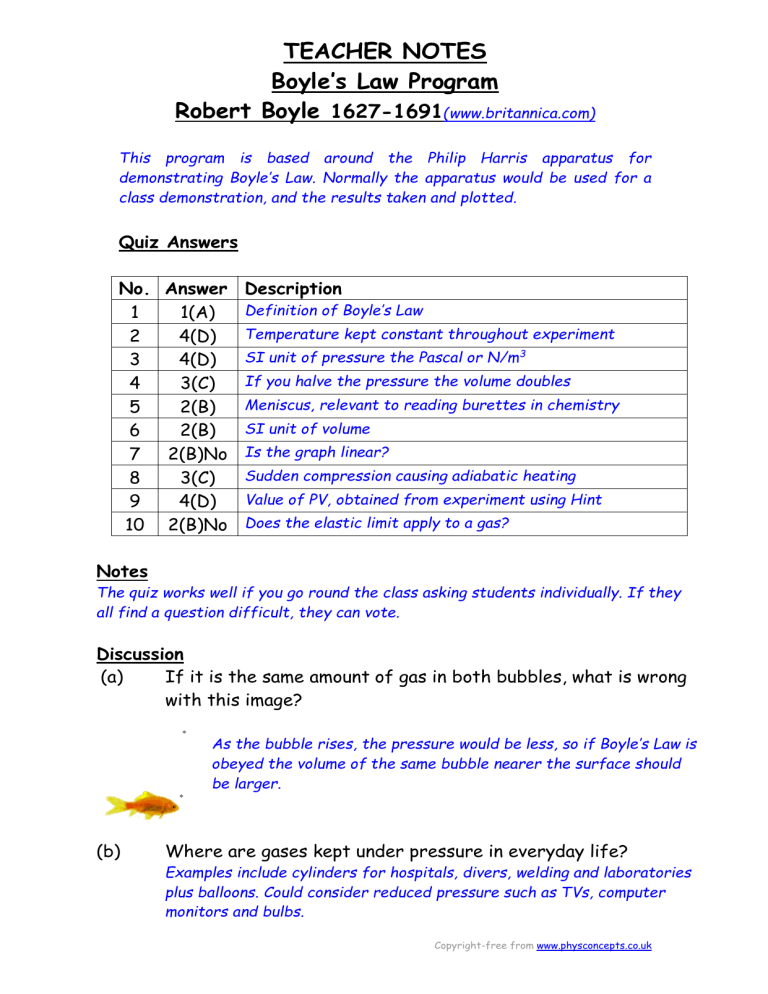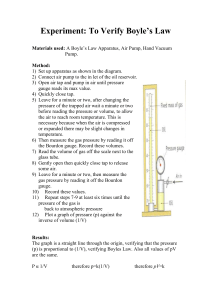Boyle's Law

TEACHER NOTES
Boyle’s Law Program
Robert Boyle
1627-1691
(www.britannica.com)
This program is based around the Philip Harris apparatus for demonstrating Boyle’s Law. Normally the apparatus would be used for a class demonstration, and the results taken and plotted.
Quiz Answers
No. Answer Description
1 1(A) Definition of Boyle’s Law
2 4(D) Temperature kept constant throughout experiment
3 4(D) SI unit of pressure the Pascal or N/m 3
4 3(C) If you halve the pressure the volume doubles
5 2(B) Meniscus, relevant to reading burettes in chemistry
6 2(B) SI unit of volume
7 2(B)No Is the graph linear?
8 3(C) Sudden compression causing adiabatic heating
9 4(D) Value of PV, obtained from experiment using Hint
10 2(B)No Does the elastic limit apply to a gas?
Notes
The quiz works well if you go round the class asking students individually. If they all find a question difficult, they can vote.
Discussion
(a) If it is the same amount of gas in both bubbles, what is wrong
(b) with this image?
As the bubble rises, the pressure would be less, so if Boyle’s Law is obeyed the volume of the same bubble nearer the surface should be larger.
Where are gases kept under pressure in everyday life?
Examples include cylinders for hospitals, divers, welding and laboratories plus balloons. Could consider reduced pressure such as TVs, computer monitors and bulbs.
Copyright-free from www.physconcepts.co.uk
Boyle’s Law Worksheet
Use the program to fill in the values
There could be a class discussion about experimental errors as to why the PV column is not exactly constant. If actual apparatus used, the PV column will vary because of heating with compression and cooling when expanding.
P/1x10 5 Pa V/cm 3 PxV/1x10 5 Pa cm 3
1.0
1.5
2.0
2.5
3.0
50.0
33.3
25.0
20.0
16.7
50.0
49.9
50.0
50.0
50.1
Now try plotting the graph.
Copyright-free from www.physconcepts.co.uk
Boyle’s Law Experiment
Diagram
Volume V
Pressure P
Valve
Hydraulic
Fluid
Air
Pump
Method
Initially the volume V of the trapped air can be read at one atmosphere
(if set up correctly.) The pump can then be used to build up the pressure
P inside the apparatus. The oil compresses the trapped air, and decreases its volume. It may be necessary to allow the air to cool between measurements if there has been a very rapid compression. The readings can be checked by slowly releasing the pressure by opening the valve.
This time cooling will occur, and this could lead to a discussion about refrigeration.
Results
P/1x10 5 Pa V/cm 3 PxV/1x10 5 Pa cm 3
1.0
Conclusion
If Boyle’s Law is obeyed, PxV should be a constant. Could be a chance to discuss experimental errors.
Copyright-free from www.physconcepts.co.uk
Boyle’s Law Problems/Homework/Test
1. Define Boyle’s Law
For a fixed mass of dry gas at constant temperature, the volume is inversely proportional to the pressure.
2. In the Boyle’s Law experiment you can have:
(Tick the correct statements.)
(Mouse-over Boyle’s Law on the first screen brings up the definition)
High Pressure and Low Volume
Low Pressure and Low Volume
High Pressure and High Volume
Low Pressure and High Volume
3. A bicycle pump has its outlet closed off, and it contains air at a volume of 50 cm 3 and pressure of 1.0x10
5 Pa. If the volume is reduced to 12.5 cm 3 , what will be the new pressure?
P
1
V
1
= P
2
V
2
so 1.0x10
Hence P
2
= 1.0x10
5
5 x 50 = P
2
x 12.5
x 50 / 12.5 = 4.0x10
5 Pa
N.B. The left hand side units must be the same as the right hand side units.
4. A fish in deep water at a pressure of 5 atmospheres releases a bubble of volume 2 cm 3 . Calculate the volume of the bubble just before it breaks the surface (assume the pressure will now be 1 atmosphere.)
P
1
V
1
= P
2
V
2
so 5 x 2 = 1 x V
V
2
= 10 cm 3
2
5. A helium balloon at sea-level has a volume of 33 m 3 at a pressure of 1.0x10
5 Pa. When released into the upper atmosphere its volume becomes 50 m 3 . What is the new pressure?
P
P
1
2
V
1
= P
2
V
2
= 1 x 10
so 1 x 10
5
5 x 33 = P x 33 / 50
2
x 50
P
2
= 66000 Pa or 6.6 x 10 4 Pa
Copyright-free from www.physconcepts.co.uk






